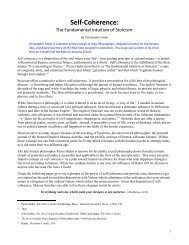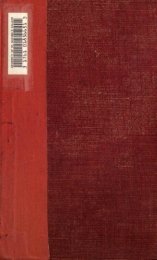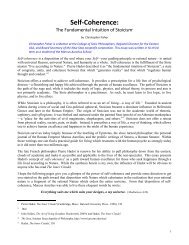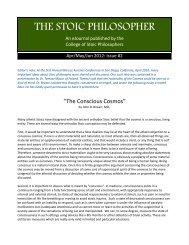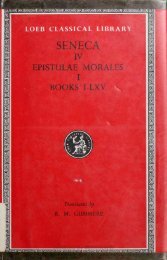- Page 1 and 2:
LOEB CLASSICAL LIBRARY SENECA v EPI
- Page 3:
876 SENECA sENECAf LUCIUS ANNAEUSt
- Page 7 and 8:
SENECA IN TEN VOLUMES V AD LUCILIUM
- Page 9 and 10:
CONTENTS OF VOLUME II LETTERS PACK
- Page 11 and 12:
THE EPISTLES OF SENECA
- Page 13 and 14:
THE EPISTLES OF SENECA LXVI. ON VAR
- Page 15 and 16:
EPISTLE LXVI. me to breed certain m
- Page 17 and 18:
EPISTLE LXVI. be avoided, establish
- Page 19 and 20:
is nothing else than a portion of t
- Page 21 and 22:
EPISTLE LXVI. in a human body. a If
- Page 23 and 24:
EPISTLE LXVI. which it deals ; if t
- Page 25 and 26:
EPISTLE LXVI. " Are you trying to m
- Page 27 and 28:
EPISTLE LXVI. he will entrust himse
- Page 29 and 30:
and toil. EPISTLE LXVI. Or, if you
- Page 31 and 32:
EPISTLE LXV1. It is because nothing
- Page 33 and 34:
EPISTLE LXVI. reason that both thes
- Page 35 and 36:
EPISTLE LXVI. succession of actions
- Page 37 and 38:
EPISTLE LXVI. but a good itself nev
- Page 39 and 40:
EPISTLE LXVI. even though death has
- Page 41 and 42:
EPISTLE LXV1. absence of pain ? The
- Page 43 and 44:
EPISTLE LXVI. thus, must be welcome
- Page 45 and 46:
EPISTLES LXVI., LXVII. those other
- Page 47 and 48:
EPISTLE LXVII. the middle of summer
- Page 49 and 50:
EPISTLE LXVI1. Certain of our schoo
- Page 51 and 52:
EPISTLE JLXVII. honour, I have pray
- Page 53 and 54:
EPISTLE LXVII. desirable which come
- Page 55 and 56:
EPISTLES LXVIL, LXVII1. to the stak
- Page 57 and 58:
EPISTLE LXVIII. you, that you keep
- Page 59 and 60:
EPISTLE LXVIII. another drains and
- Page 61 and 62:
EPISTLE LXVII1. falling back upon t
- Page 63 and 64:
EPISTLES LXVIII., LXIX. however, th
- Page 65 and 66:
EPISTLE LXIX. used to crave so pass
- Page 67 and 68:
EPISTLE LXX. LXX. ON THE PROPER TIM
- Page 69 and 70:
EPISTLE LXX. are aware, one should
- Page 71 and 72:
EPISTLE LXX. are times, nevertheles
- Page 73 and 74:
EPISTLE LXX. you find in doing anot
- Page 75 and 76:
EPISTLE LXX. speedily as possible o
- Page 77 and 78:
EPISTLE LXX. take thought of his ow
- Page 79 and 80:
EPISTLE LXX. the breath from his bo
- Page 81 and 82:
He EPISTLE LXX. departure, nothing
- Page 83 and 84:
EPISTLES LXX., LXXI. Reason, too, a
- Page 85 and 86:
EPISTLE LXXI. The archer must know
- Page 87 and 88:
EPISTLE LXXI snce virtue has made t
- Page 89 and 90:
EPISTLE LXXI he had returned victor
- Page 91 and 92:
EPISTLE LXXI. nient ? For what is f
- Page 93 and 94:
EPISTLE LXXI. by destructions of va
- Page 95 and 96:
EPISTLE LXXI. inflicting them, and
- Page 97 and 98:
EPISTLE LXXI. Itself be made more s
- Page 99 and 100:
EPISTLE LXXI. actions are not essen
- Page 101 and 102:
' EPISTLE LXXI. latter is situated
- Page 103 and 104:
EPISTLE LXXI. that which I recommen
- Page 105 and 106:
EPISTLE LXXI. so much progress that
- Page 107 and 108:
EPISTLE LXXII. LXXII. ON BUSINESS A
- Page 109 and 110:
EPISTLE LXXII. for no amount of tim
- Page 111 and 112:
EPISTLE LXXII. between a healthy ma
- Page 113 and 114:
EPISTLE LXXII. opens his jaws in th
- Page 115 and 116:
EPISTLE LXX1II. LXXIII. ON PHILOSOP
- Page 117 and 118:
EPISTLE LXXIII. he may retire to no
- Page 119 and 120:
EPISTLE LXXIII. and to the god who
- Page 121 and 122:
EPISTLE LXX1II. for him to enjoy ri
- Page 123 and 124:
EPISTLES LXXIII., LXXIV. them to ot
- Page 125 and 126:
EPISTLE LXXIV. to consist in the be
- Page 127 and 128:
EPISTLE LXXIV. the region round abo
- Page 129 and 130:
EPISTLE LXXIV. them, and, just beca
- Page 131 and 132:
EPISTLE LXXIV. upright men often su
- Page 133 and 134:
EPISTLE LXXIV. fortunate than God,
- Page 135 and 136:
EPISTLE LXXIV. " " preferred things
- Page 137 and 138:
EPISTLE LXXIV. should fortify ourse
- Page 139 and 140:
EPISTLE LXXIV. governed country, an
- Page 141 and 142:
EPISTLE LXXIV. sufficient ; for the
- Page 143 and 144:
EPISTLE LXXIV. spread, governing ki
- Page 145 and 146:
EPISTLE LXXIV. colour," his counten
- Page 147 and 148:
EPISTLES LXXIV., LXXV. unless he ha
- Page 149 and 150:
EPISTLE LXXV. I prefer, however, th
- Page 151 and 152:
EPISTLE LXXV. has during a plague.
- Page 153 and 154:
EPISTLE LXXV. but not yet the passi
- Page 155 and 156:
EPISTLE LXXV. of many of the vices
- Page 157 and 158:
EPISTLES LXXV., LXXVI. no greater p
- Page 159 and 160:
EPISTLE LXXV1. the races, and allow
- Page 161 and 162:
EPISTLE LXXVI. to make. Why do you
- Page 163 and 164:
EPISTLE LXXVI. swift ; so is the ho
- Page 165 and 166:
EPISTLE LXXVI. will disapprove of h
- Page 167 and 168:
EPISTLE LXXVI. willed. It is this t
- Page 169 and 170:
EPISTLE LXXVI. else good except tha
- Page 171 and 172:
EPISTLE LXXVI. variance with reason
- Page 173 and 174:
EPISTLE LXXVI. lead a happy life wh
- Page 175 and 176:
EPISTLE LXXVI. of some last noble e
- Page 177 and 178:
EPISTLE LXXVI. which he is clothed.
- Page 179 and 180:
1 EPISTLES LXXVL, LXXVII. others li
- Page 181 and 182:
EPISTLE LXXVII. were progressing ab
- Page 183 and 184:
this feeling is. 173 EPISTLE LXXVII
- Page 185 and 186:
EPISTLE LXXVII. This little anecdot
- Page 187 and 188:
EPISTLE LXXVII. multitudes who will
- Page 189 and 190:
EPISTLE LXXV1I. cloyed with it. You
- Page 191 and 192:
EPISTLES LXXVIL, LXXVIII. honourabl
- Page 193 and 194:
EPISTLE LXXVIII. had the power to d
- Page 195 and 196:
EPISTLE LXXVIII. and cavity of whic
- Page 197 and 198:
EPISTLE LXXVIII. whether because th
- Page 199 and 200:
EPISTLE LXXVIII. desire are wearied
- Page 201 and 202:
EPISTLE LXXVIII. ills, and tells li
- Page 203 and 204:
EPISTLE LXXVIII. you relieved from
- Page 205 and 206:
EPISTLE LXXVI1I. and that drives th
- Page 207 and 208:
EPISTLE LXXVIII. a man is, the more
- Page 209 and 210:
EPISTLE LXXVIII. the limits of good
- Page 211 and 212:
EPISTLE LXX1X. LXXIX. ON THE REWARD
- Page 213 and 214:
EPISTLE LXXIX. growing smaller beca
- Page 215 and 216:
EPISTLE LXXIX. approach a subject t
- Page 217 and 218:
EPISTLE LXXIX. yours can collapse a
- Page 219 and 220:
EPISTLE LXXIX. her will. But, as th
- Page 221 and 222:
EPISTLE LXXIX. and he were not well
- Page 223 and 224:
EPISTLE LXXX. LXXX. ON WORLDLY DECE
- Page 225 and 226:
EPISTLE LXXX. with his own blood, i
- Page 227 and 228:
EPISTLE LXXX. man smiles more often
- Page 229 and 230:
EPISTLES LXXX., LXXXI. judge him wh
- Page 231 and 232:
EPISTLE LXXXI. a hand when he confe
- Page 233 and 234:
EPISTLE LXXXI. respect for the man,
- Page 235 and 236:
EPISTLE LXXXI. upon everything; for
- Page 237 and 238:
EPISTLE LXXXI. thousand denarii giv
- Page 239 and 240:
EPISTLE LXXXI. thousand denarii giv
- Page 241 and 242:
EPISTLE LXXXI. anyone who receives
- Page 243 and 244:
EPISTLE LXXXI. in order that I may
- Page 245 and 246:
EPISTLE LXXXI. I may use the term,
- Page 247 and 248:
EPISTLE LXXXI. deserved well of him
- Page 249 and 250:
EPISTLE LXXXI. we should take couns
- Page 251 and 252:
EPISTLES LXXXI., LXXX1I. have recei
- Page 253 and 254:
EPISTLE LXXXI1. lying idle and lyin
- Page 255 and 256:
EPISTLE LXXXII. the madness of our
- Page 257 and 258:
EPISTLE LXXXII. not easily tell you
- Page 259 and 260:
EPISTLE LXXXII. of Brutus a forthwi
- Page 261 and 262:
EPISTLE LXXXII. for there are impla
- Page 263 and 264:
human mind ? EPISTLE LXXXI1. For th
- Page 265 and 266:
EPISTLE LXXXII. think that Zeno's a
- Page 267 and 268:
EPISTLE LXXX11. of these men did no
- Page 269 and 270:
EPISTLES LXXXII., LXXXII1. toughnes
- Page 271 and 272:
EPISTLE LXXXIII. To-day has been un
- Page 273 and 274:
EPISTLE LXXXI1I. sun, at times when
- Page 275 and 276:
EPISTLE LXXXIII. many, but one will
- Page 277 and 278:
EPISTLE LXXXIII. With regard to the
- Page 279 and 280: EPISTLE LXXXIII. orders, written in
- Page 281 and 282: EPISTLE LXXXIII. how often the drun
- Page 283 and 284: EPISTLE LXXXIII. However, at the ti
- Page 285 and 286: EPISTLE LXXXII1. no match for his e
- Page 287 and 288: EPISTLES LXXXIIL, LXXXIV. and his t
- Page 289 and 290: EPISTLE LXXXIV. pack close the flow
- Page 291 and 292: EPISTLE LXXXIV. on our part ; the f
- Page 293 and 294: EPISTLE LXXXIV. another the bariton
- Page 295 and 296: EPISTLES LXXXIV., LXXXV. an insult
- Page 297 and 298: EPISTLE LXXXV. enter the arena and
- Page 299 and 300: EPISTLE LXXXV. Tliis is speed estim
- Page 301 and 302: EPISTLE LXXXV. be, it knows no obed
- Page 303 and 304: EPISTLE LXXXV. in proportion as the
- Page 305 and 306: EPISTLE LXXXV. alter the earlier ha
- Page 307 and 308: EPISTLE LXXXV. cannot discover how
- Page 309 and 310: EPISTLE LXXXV. source of this error
- Page 311 and 312: EPISTLE LXXXV. vices of less degree
- Page 313 and 314: EPISTLE LXXXV. serve this liberty.
- Page 315 and 316: EPISTLE LXXXV. squalls, inasmuch as
- Page 317 and 318: EPISTLE LXXXV. holds the ship in ir
- Page 319 and 320: EPISTLE LXXXV. thing which engages
- Page 321 and 322: EPISTLES LXXXV., LXXXVI. feared ; b
- Page 323 and 324: EPISTLE LXXXVI. to the laws and wit
- Page 325 and 326: EPISTLE LXXXVI. I spigots. have so
- Page 327 and 328: EPISTLE LXXXVI. as aedile, or Fabiu
- Page 329: EPISTLE LXXXVI. spick - and - span
- Page 333 and 334: EPISTLES LXXXVI., LXXXVII. of young
- Page 335 and 336: EPISTLE LXXXVII. loss, whenever it
- Page 337 and 338: EPISTLE LXXXVII. have uttered an op
- Page 339 and 340: EPISTLE LXXXVII. Marcus Cato the Ce
- Page 341 and 342: EPISTLE LXXXVII. good man ; therefo
- Page 343 and 344: EPISTLE LXXXVII. soul ; they do not
- Page 345 and 346: EPISTLE LXXXVII. inactivity as a go
- Page 347 and 348: EPISTLE LXXXV1I. must perforce admi
- Page 349 and 350: EPISTLE LXXXVII. an act of sacrileg
- Page 351 and 352: EPISTLE LXXXYII. but riches give us
- Page 353 and 354: EPISTLE LXXXVI1. things are not " g
- Page 355 and 356: EPISTLE LXXXVII. You " have/' says
- Page 357 and 358: EPISTLES LXXXVIL, LXXXVIII. were be
- Page 359 and 360: EPISTLE LXXXVIII. subject. The scho
- Page 361 and 362: EPISTLE LXXXVIII. irreconcilable wi
- Page 363 and 364: EPISTLE LXXXV1I1. rather what purit
- Page 365 and 366: EPISTLE LXXXVIII. father? Can you e
- Page 367 and 368: EPISTLE LXXXVIII. intervals of the
- Page 369 and 370: EPISTLE LXXXVIII. ' pleasures. For
- Page 371 and 372: EPISTLE LXXXVI1I. Posidonius a divi
- Page 373 and 374: EPISTLE LXXXVIII. aid us and yet ar
- Page 375 and 376: EPISTLE LXXXVIII. favour arrives at
- Page 377 and 378: ' EPISTLE LXXXVIII. such character
- Page 379 and 380: EPISTLE LXXXVIII. begin along with
- Page 381 and 382:
EPISTLE LXXXVIII. of intemperance.
- Page 383 and 384:
EPISTLE LXXXVIII. Apion, the schola
- Page 385 and 386:
EPISTLES LXXXVIIL, LXXXIX. exists o
- Page 387 and 388:
EPISTLE LXXXIX. namely, the parts o
- Page 389 and 390:
EPISTLE LXXXIX. In the first place,
- Page 391 and 392:
i.r,., logic. 383 EPISTLE LXXXIX. p
- Page 393 and 394:
EPISTLE LXXXIX. a different subject
- Page 395 and 396:
EPISTLE LXXXIX. left to him ; for h
- Page 397 and 398:
EPISTLE LXXXIX. left to him ; for h
- Page 399 and 400:
EPISTLE LXXXIX. object arises in ea
- Page 401 and 402:
EPISTLE LXXXIX. kind, as much as yo
- Page 403 and 404:
EPISTLE LXXXIX. this custom continu
- Page 405 and 406:
EPISTLES LXXXIX., XC. provided that
- Page 407 and 408:
EPISTLE XC. together in close-unite
- Page 409 and 410:
EPISTLE XC. They kept their hands u
- Page 411 and 412:
EPISTLE XC. cliff or by the trunk o
- Page 413 and 414:
EPISTLE XC. sloping they contrived
- Page 415 and 416:
EPISTLE XC. broke it, upbraiding hi
- Page 417 and 418:
EPISTLE XC. trees ? Are not the fea
- Page 419 and 420:
EPISTLE XC. all, and obtainable for
- Page 421 and 422:
EPISTLE XC. upright warp keeps the
- Page 423 and 424:
EPISTLE XC. whatever grain slips ou
- Page 425 and 426:
EPISTLE XC. to his meaner assistant
- Page 427 and 428:
EPISTLE XC. control ; for he whom l
- Page 429 and 430:
] EPISTLE XC. marks whereby truth i
- Page 431 and 432:
EPISTLE XC. But Posidoiiius again r
- Page 433 and 434:
EPISTLE XC. need of happiness, and
- Page 435 and 436:
she was the parent, of all ; EPISTL
- Page 437 and 438:
EPISTLE XC. unused, and the hand, u
- Page 439 and 440:
EPISTLE XC. these days, however, ou
- Page 441 and 442:
EPISTLES XC., XCI. and even in the
- Page 443 and 444:
EPISTLE XCI. it ? When weapons are
- Page 445 and 446:
EPISTLE XC1. War arises in the mids
- Page 447 and 448:
EPISTLE XCI. and should fortify our
- Page 449 and 450:
EPISTLE XCI. not very large in exte
- Page 451 and 452:
EPISTLE XCI. mortality, and in the
- Page 453 and 454:
EPISTLE XC1 not cry out at any of t
- Page 455 and 456:
EPISTLE XCI. comprehended by a madm
- Page 457 and 458:
EPISTLES XCI., XCII. Meanwhile it i
- Page 459 and 460:
EPISTLE XC1I. less strong than he i
- Page 461 and 462:
EPISTLE XCI1. a spark have in the m
- Page 463 and 464:
EPISTLE XCII. which harmonize but i
- Page 465 and 466:
EPISTLE XCII. walk as I should, or
- Page 467 and 468:
EPISTLE XCII. serious, that he is c
- Page 469 and 470:
EPISTLE XCII. he is free from cloud
- Page 471 and 472:
EPISTLE XCII. ills do not make a ma
- Page 473 and 474:
EPISTLE XCII. he has lived longer a
- Page 475 and 476:
EPISTLE XCII. fortune the wise man
- Page 477 and 478:
EPISTLE XCII. But He in whose body
- Page 479 and 480:
EPISTLE XCII, by the boundaries of
- Page 481 and 482:
EPISTLE XCII. by the executioner's
- Page 483 and 484:
LXXVI. 20. LXXVI1. 17. APPENDIX Q a
- Page 485 and 486:
the chalice to our own 1 lips,' Ixx
- Page 487 and 488:
INDEX Leonidas at Thermopylae), Ixx
- Page 489 and 490:
INDEX 16 ; late-won renown of, P. C
- Page 491 and 492:
THE LOEB CLASSICAL LIBRARY VOLUMES
- Page 493 and 494:
THE LOEB CLASSICAL LIBRARY OVID : T
- Page 495 and 496:
THE LOEB CLASSICAL LIBRARY ARISTOTL
- Page 497 and 498:
THE LOEB CLASSICAL LIBRARY Edgar. 2
- Page 504:
Other philosophical writers in the




